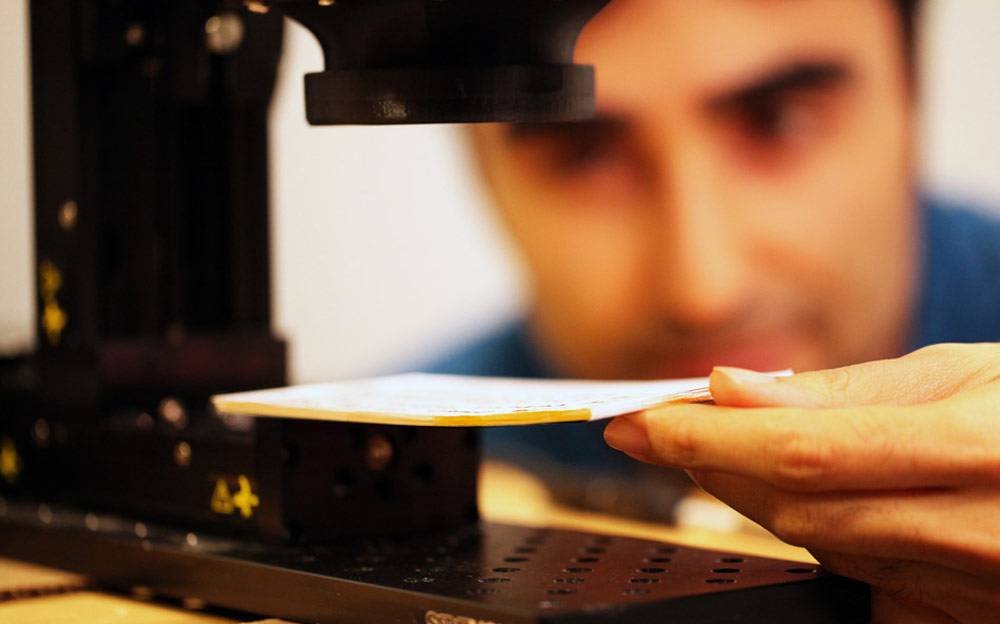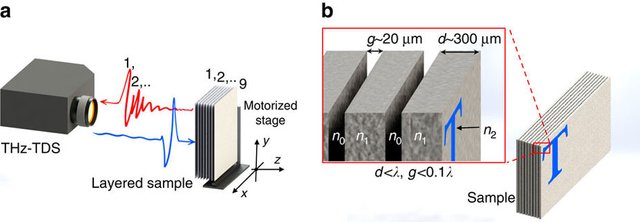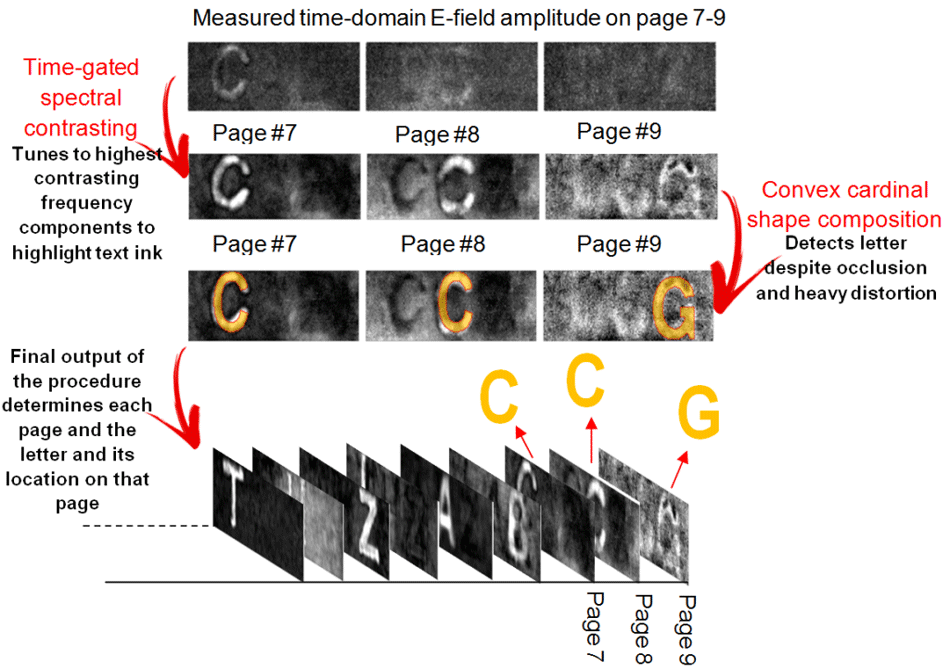
The idea of reading a book without opening it looks like a fantasy or a science fiction. But now it is going to be a reality as MIT researchers have found a method to do that. They are working on an imaging system that can read closed books. So, the popular saying, "Don't judge a book through is cover", is going to be proved incorrect.
The MIT researchers have created a prototype of the imaging system and tested it on a stack of papers each with a printed letter on it. The system was able to correctly identify letters up to the depth of 9 pages. They call this technology Terahertz Time-Gated Spectral Imaging.

Terahertz Radiation
The system uses terahertz radiation, the band of electromagnetic radiation which lies between microwaves and infrared light. They use the frequency in the range of 100 GHz to 3 THz, which can penetrate through paper and other materials. Terahertz radiation is much better than other types of waves that can penetrate surfaces, such as X-rays or sound waves. This is because Terahertz radiation passes through objects (like paper) and reflected back differently by different chemicals (like ink, paper etc.). As different chemical observe different frequencies of Terahertz radiation to different degrees, showing a distinctive frequency signature for each [1], Terahertz has been widely used for security screening, checking hidden documents, chemicals or other material in envelope or parcel.
How Does It Work?

Terahertz imaging is used on a stack of paper | Credit: Barmak Heshmat/MIT
Conventionally time-of-flight imaging has been used in imaging fast phenomena (Femto photography) and complex geometry. As I have discussed my previous posts that time and space are tied together with the speed of light (x=ct). Higher time resolution will result in finer space resolution (think about how smooth high FPS videos are!).
The Terahertz radiation is also emitted in short bursts with very high resolution of time (10 trillion frames per second). Such high time resolution provides space resolution of about 30 micron which is high enough to separate pages of a closed book. This process is actually called TeraHertz time-gated Spectroscopy. When Terahertz radiation is emitted in short pulses towards the books some radiation is reflected by the ink on the pages. The difference in time between the emission time and the time at which reflected radiation returns to the sensor gives us the information about the distance traveled by the radiation. This gives a much better idea of depth than ultrasound.

(a) The reflected signal (shown in red) has a series of dense reflections (usually more than nine) from the layered sample that provides time-of-flight information for boundaries of pages. (b) The layered sample is composed of nine packed paper layers. Each layer is 300 μm thick and the non-uniform gaps between the layers are ∼20 μm after pressing the pages together. [2]
The system exploits the fact that pages have rough surface due to which some air packets do get trapped between them. The difference in refractive index between the air and the paper gives an idea of boundary after analyzing the reflected radiation. This data is used decide the depth from where the required Terahertz radiation carrying the image of the text was reflected back.
They have created an algorithm with which they can analyze the time difference, the intensity and the frequency of reflected wave to create an image of the text available on each page.
The Challenges
The first thing to deal with is the "noise", the non-wanted spurious signal or waves generated during the process. While most of the radiation either gets absorbed or reflected back by the book some of it just bounces around between the pages before returning to the sensor, producing some deceiving signals. Sensor's electronics also produce some unwanted vibrations which add to the noise. So, MIT researchers are working on a method to filter out all this noise.
The present prototype can correctly derive the distance from the camera to the top twenty pages in a stack, but beyond a depth of 9 pages, the intensity of the reflected signal is so low that the original frequency signal is overpowered by the noise. Terahertz imaging is still a relatively young technology and researchers are working hard to improve it. They are constantly working to improve the accuracy of the detectors as well as the intensity of the radiation, so that deeper scanning should be possible.

Spectral contrasting and letter extraction from contrasted images | [3]
They are working on an algorithm to correctly detect text in different scripts. There are also working to exclude shades of text previous page and other noise in the text. There is yet another limitation because of warping of thin pages. Such warping can create sweeping distortions in the signal. However, there is work going on to solve this problem as well.
The Conclusion
The research and innovations like these do give us a hint about our future. This technology will be very much useful in studying antique books, ancient manuscripts without harming them. It can also be used on things other than books – layers of paint, for example, in the famous piece of art or materials stacked tightly in archaeological samples. In future, probably these tools will become handy and we will be able to use these tools to do so many things, like reading a letter without opening the envelope. But if that happens, our security and privacy will be at risk. So, for tackling such issues, a special type of ink has been developed which can reduce the risk of such dangers. So, the awesomeness of this great innovation continues.
Laura Waller, a professor of electrical engineering and computer science and the University of California at Berkeley, remarks:
"This work (terahertz time-gated spectral imaging) is one of the first to use these new tools along with advances in computational imaging to get at pictures of things we could never see with optical technologies. Now we can judge a book through its cover!"
Thank you so much for giving your time to read this post. Hope you enjoyed reading it. 🙂
If you have any thoughts or want to add something don't forget to leave a comment. 😉
If you find this post useful and informative don't forget to give an UPVOTE and a RESTEEM.
Image Source :
All the non cited images are from Pixabay.com, Pexels.com, or Wikipedia.com and are available for Reuse under Creative Commons Licenses.
References
[1] - http://news.mit.edu/2016/computational-imaging-method-reads-closed-books-0909
[2] - https://www.nature.com/articles/ncomms12665
[3] - http://cameraculture.media.mit.edu/can-computers-read-through-closed-books/
[•] - https://en.wikipedia.org/wiki/Terahertz_time-domain_spectroscopy
[•] - http://www.osbusters.net/2017/11/what-is-terahertz-imaging-can-we-read-closed-books-using-it.html
Previous Episodes of the Series
- Tech Bits #1 : Five Tools to Make Your Online Study a Cakewalk
- Tech Bits #2 - Mediatek vs Qualcomm : Which Smartphone Processor Should You Choose?
- Tech Bits #3 - How does a Lie-Detector Machine (Polygraph) work? Is it Reliable?
Follow me @nitesh9



--- thinknitesh.com ---
Well, pretty amazing, and useful for anthropology and ancient script. But when will it be ready for everyday use? I am trying to get as lazy as possible, and turning pages has always been a burden I've longed to overcome.
Downvoting a post can decrease pending rewards and make it less visible. Common reasons:
Submit
Ha ha. We hope, it will be available commercially in near future after they make it more powerful and accurate. ;)
Downvoting a post can decrease pending rewards and make it less visible. Common reasons:
Submit
Thank you. I follow your articles. Unique and smart. Good to meet you.
Downvoting a post can decrease pending rewards and make it less visible. Common reasons:
Submit
Thank you. :)
Downvoting a post can decrease pending rewards and make it less visible. Common reasons:
Submit
Re goodbro
Downvoting a post can decrease pending rewards and make it less visible. Common reasons:
Submit
Thanks bro. :)
Downvoting a post can decrease pending rewards and make it less visible. Common reasons:
Submit
This post has received a 3.11 % upvote from @buildawhale thanks to: @nitesh9. Send at least 1 SBD to @buildawhale with a post link in the memo field for a portion of the next vote.
To support our daily curation initiative, please vote on my owner, @themarkymark, as a Steem Witness
Downvoting a post can decrease pending rewards and make it less visible. Common reasons:
Submit
img credz: pixabay.com
Nice, you got a 30.0% @minnowbooster upgoat, thanks to @nitesh9
It consists of $6.48 vote and $2.16 curation
Want a boost? Minnowbooster's got your back!
Downvoting a post can decrease pending rewards and make it less visible. Common reasons:
Submit
The @OriginalWorks bot has determined this post by @nitesh9 to be original material and upvoted(1.5%) it!
To call @OriginalWorks, simply reply to any post with @originalworks or !originalworks in your message!
Downvoting a post can decrease pending rewards and make it less visible. Common reasons:
Submit